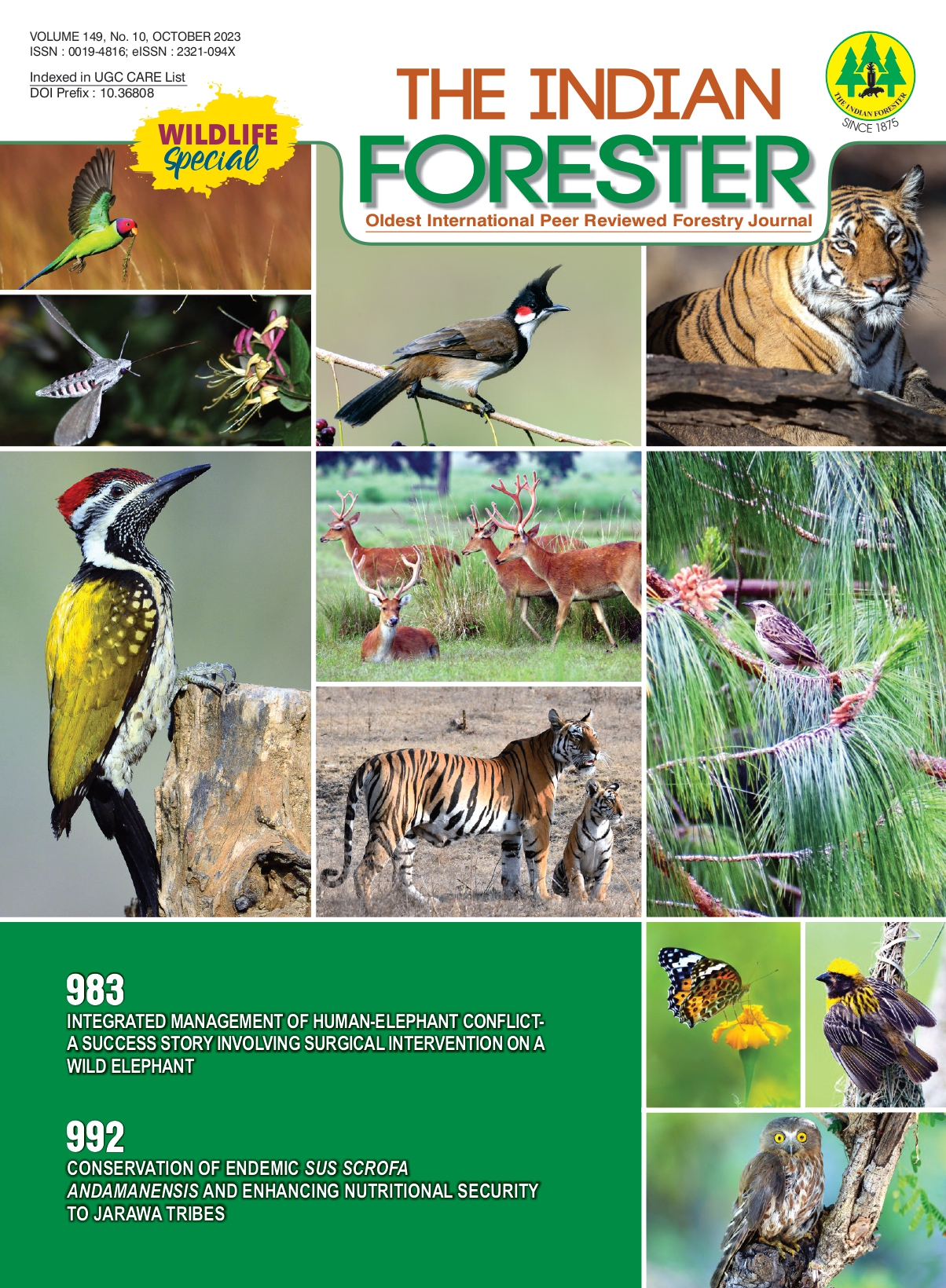Is Elephant Proof Trench an Effective Mitigating Measure against Human – Elephant Conflict?
DOI:
https://doi.org/10.36808/if/2023/v149i10/157840Keywords:
Elephant, EPT, Effectiveness, HEC, Tamil Nadu.Abstract
Human-Elephant Conflict (HEC) is one of the challenging issues posing on elephant conservation. The Elephant Proof Trench is recognized as a potential means of reducing HEC. The effectiveness of EPT in controlling HEC depends on various factors which is not studied so far. This paper describes on effectiveness of EPT in three different geographical landscapes in Tamil Nadu. In a total 470.48 km of EPTes studied in Coimbatore Forest Division, Gudalur Forest Division and Grizzled Giant Squirrel Wildlife Sanctuary altogether. Entire EPT was walked by foot to record wild animal and livestock crossing points. Line transect method was deployed to find out extent of use by wild animals along the EPT and questionnaire method was used to understand people's perception on EPT. The result revealed that there were 727 animal crossing points and 909 other than animals crossing points. The Elephant (0.63 ER/Km) was frequently used animal. Most of the people (85%) have opined that the maintenance is the duty of forest department. Huge amount being spent for digging EPT every year by the Government is ending with poor result. This present study is envisaged that policy level change is urgently warranted for successful use of EPT grant against HEC.References
Bist S.S. (2002). An overview of elephant conservation in India. Indian Forester, 122 (2): 121-136.
Balakrishnan M. and Ndhlovu D.E. (2008). Wildlife utilization and local people. A case study in Upper Lupande game management area. Zambia. Environmental Conservation, 19: 135-144.
Burnham K.P., Anderson D.R and Laake J.L. (1989). Estimation of density from line transect sampling of biological populations. Wildlife Monographs, 72: 1-202.
Fernando P., Kumar M.A., Williams A.C., Wickramanayake E., Aziz T. and Singh S.M. (2008). Review of human-elephant conflict mitigation measures practised in South Asia. AREAS Technical Support Document Submitted to World Bank, World Wide Fund for Nature.
Graham M.D. and Ochieng T. (2008). Uptake and performance of farm-based measures for reducing crop-raiding by elephants Loxodanta Africana among smallholder farms in Laikipia District, Kenya. Oryx, 42(1): 76-82.
IUCN. (2006). Asian Elephant Range States Meeting, 24-26 January 2006, Kuala Lumpur, Malaysia: Report. Switzerland.
Nelson A. Bidwell P. and Sillero-Zubiri C. (2003). A Review of Human Elephant Conflict Management Strategies. People and Wildlife Initiative, Wildlife Conservation Research Unit, Oxford University, United Kingdom.
Osborn F.V. and Anstey S. (2007). Elephant/ Human Conflict and Community Development around the Niassa Reserve, Mozambique. WWF Southern African Regional Programme. www.elephantpepper.org/downloads/Niassa%20ele%20report.pdf.
Ramakrishnan B. (1997). Status of Wildlife Corridors and their use by selected endangered mammals in the Nilgiri Biosphere Reserve, India. Ph.D., Thesis submitted to the Bharathidhasan University, Tamilnadu, India.
Ramakrishnan B. and Saravanamuthu R. (2012). Conservation and management of elephant corridors, gmbH & Co, Heinrich-Bocking-Str,Saarbrukein,Germany,66121:6-8.
Ramakrishnan B. and Saravanamuthu R. (2010). Elephant – the key stone species, Published by Tamil Nadu State Council for Science and Technology and Indo American Wildlife Society, Chennai.
Sukumar R. (2003). The Living Elephants: evolutionary ecology, behaviour and conservation. Oxford University Press, New York. Pp 478. ISBN 0-19-510778-0.
Sitati N., Walpole M.J. and Leader-Williams N. (2005). Factors affecting susceptibility of farms to crop raiding by African elephants: using a predictive model to mitigate conflict. Journal of Applied Ecology, 42: 1175-1182.
Sitati N.W. and Walpole M.J. (2006). Assessing farm-based measures for mitigation human elephant conflict in Transmara District, Kenya. Oryx, 40(3): 279-286.
Walpole M. and Linkie M. (2007). (Eds.) Mitigating Human-Elephant Conflict: case studies from Africa and Asia. Fauna & Flora International Cambridge. ISBN: 9-781903703-26-7.
Downloads
Downloads
Published
How to Cite
Issue
Section
License
Unless otherwise stated, copyright or similar rights in all materials presented on the site, including graphical images, are owned by Indian Forester.





